
SIKKIM (Dafeybhir Trek)
Discover the enchanting allure of Dafey Bhir Pass in West Sikkim with VoyaZeBuddy! Unveil nature’s canvas on this mesmerizing trek along the Singalila Range, open from March to April and September to November. Witness the breathtaking panorama of Kanchendzonga and the Sleeping Buddha. Trekking tailored for every adventurer—moderate to challenging. Join us for an unforgettable journey, where excellence meets exploration!
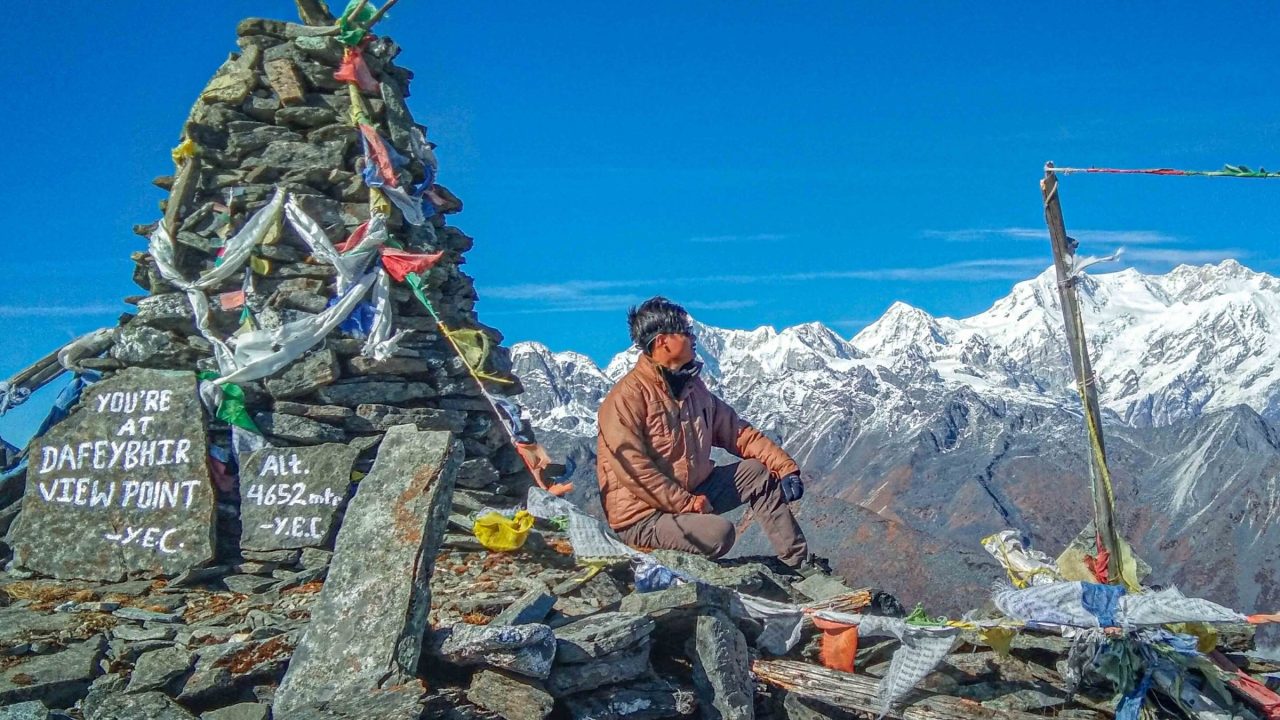

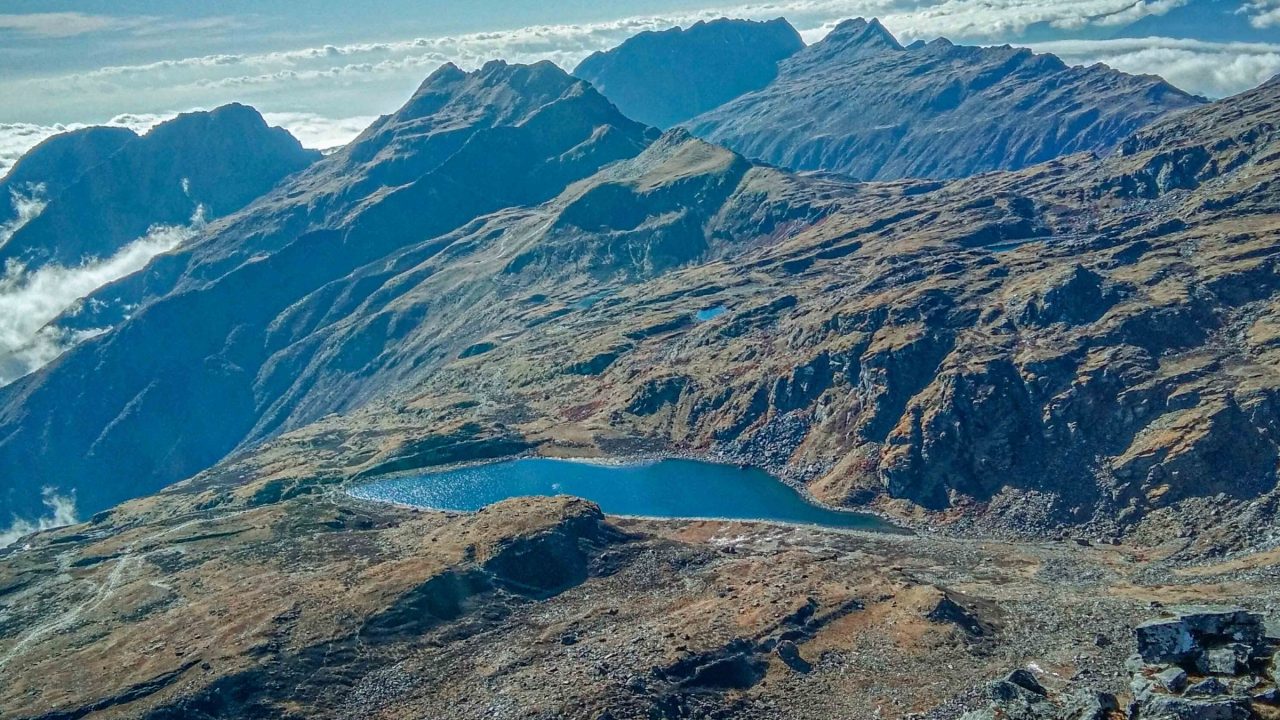
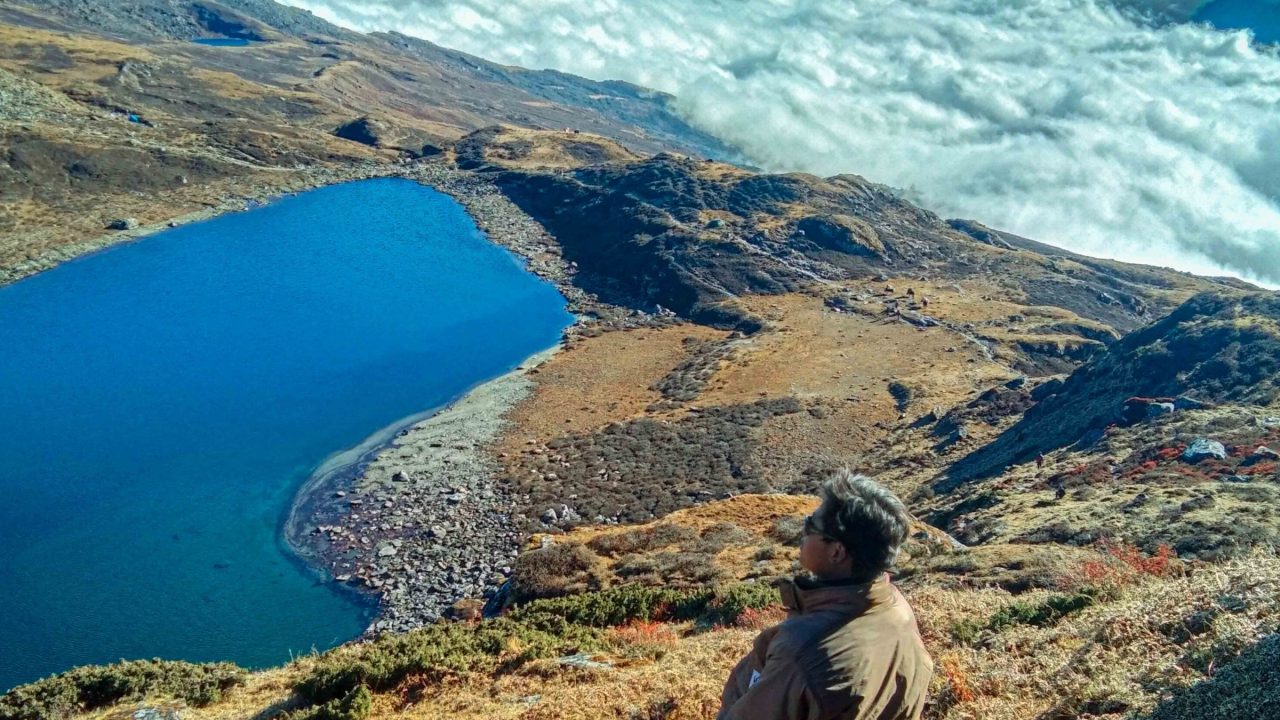
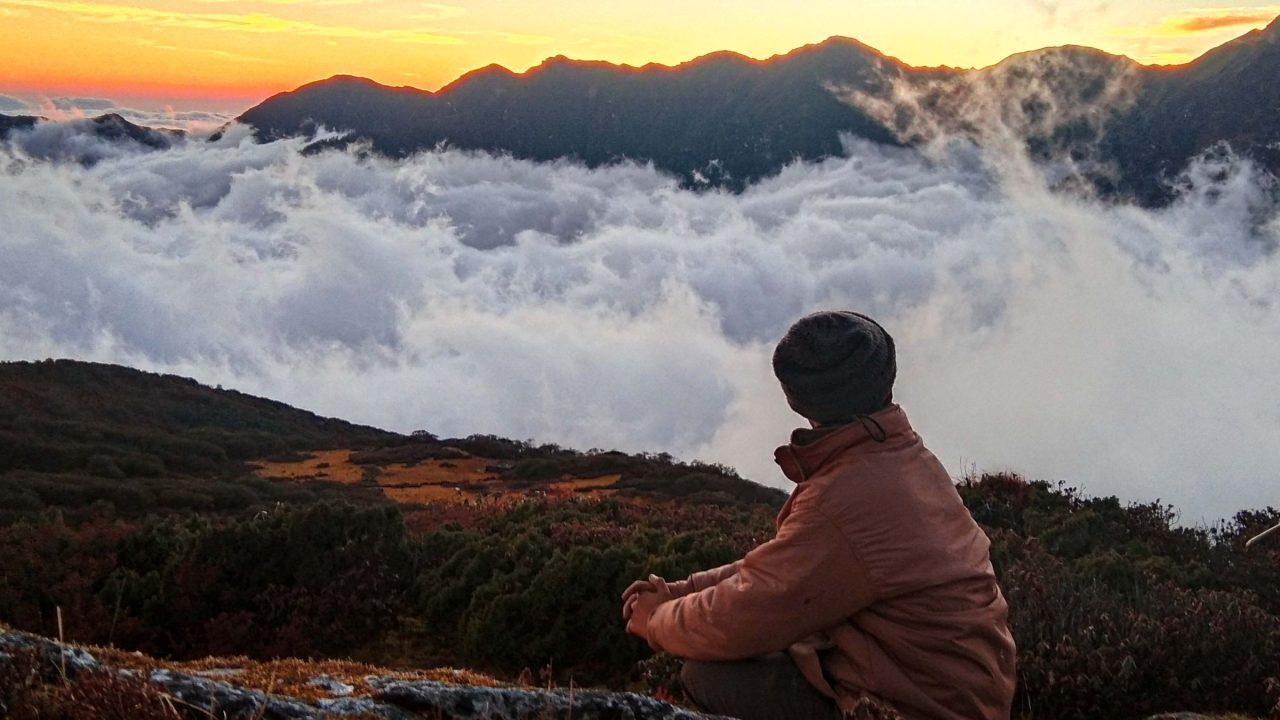
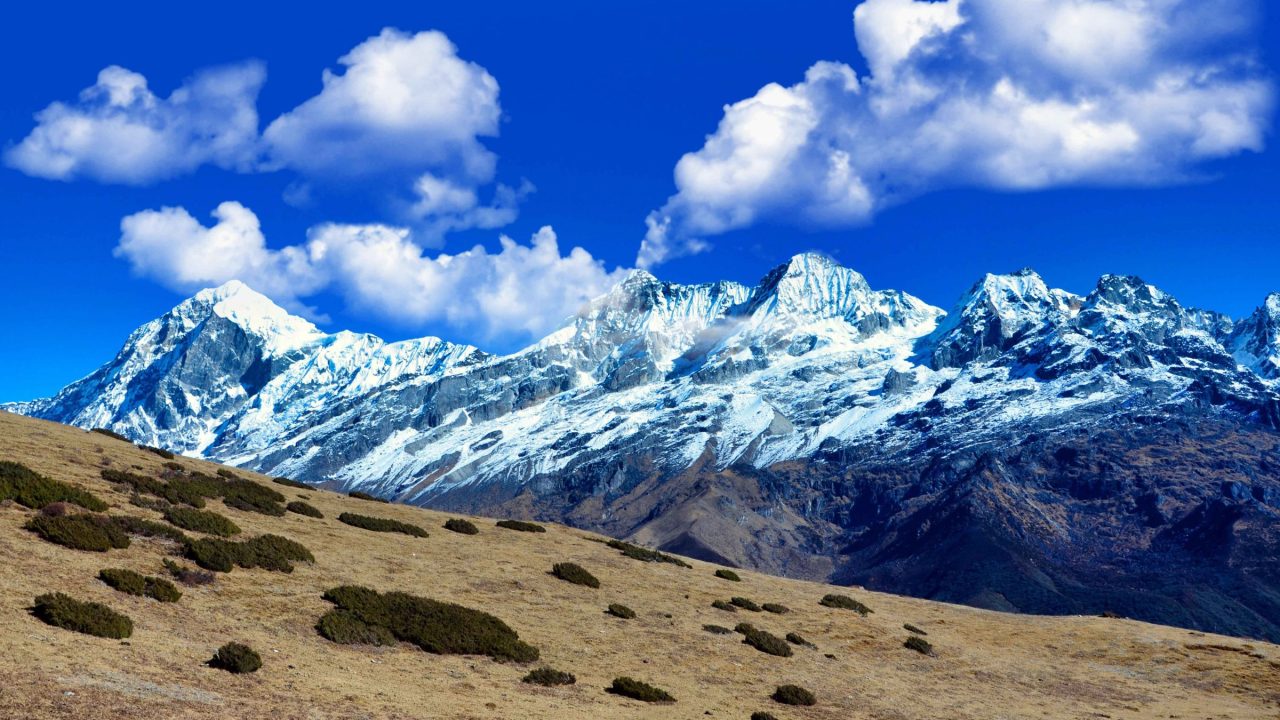
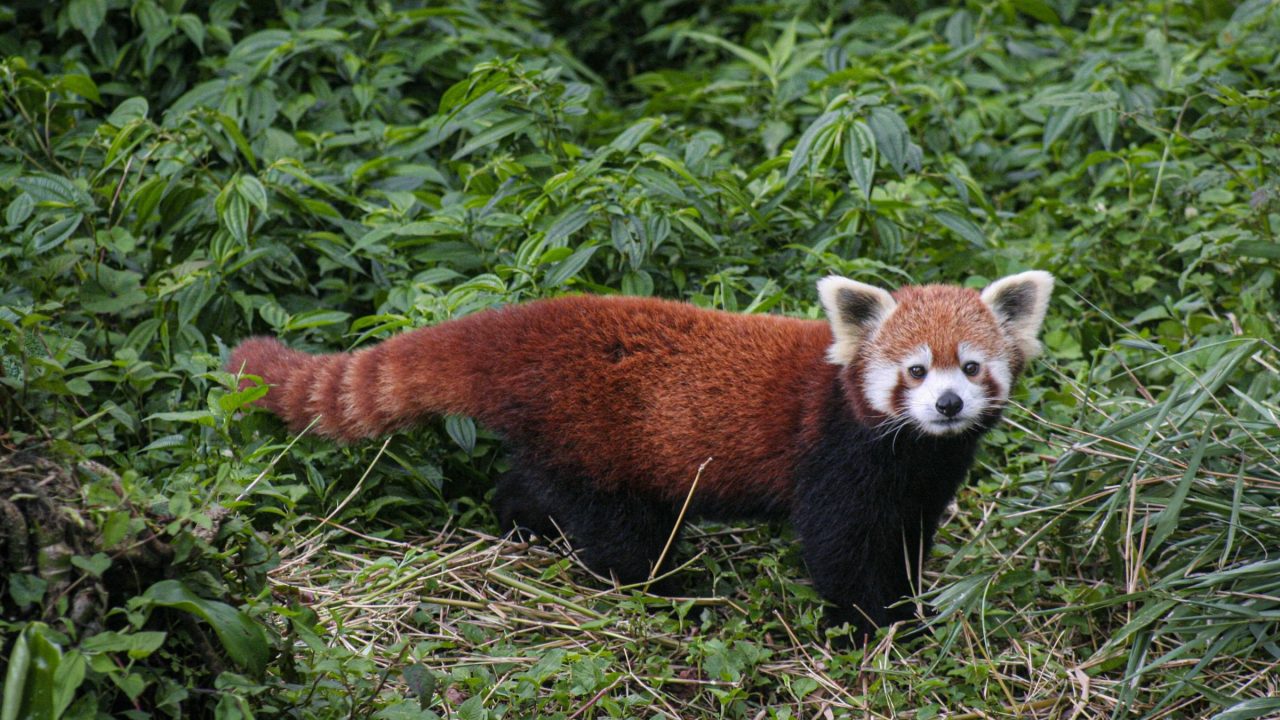
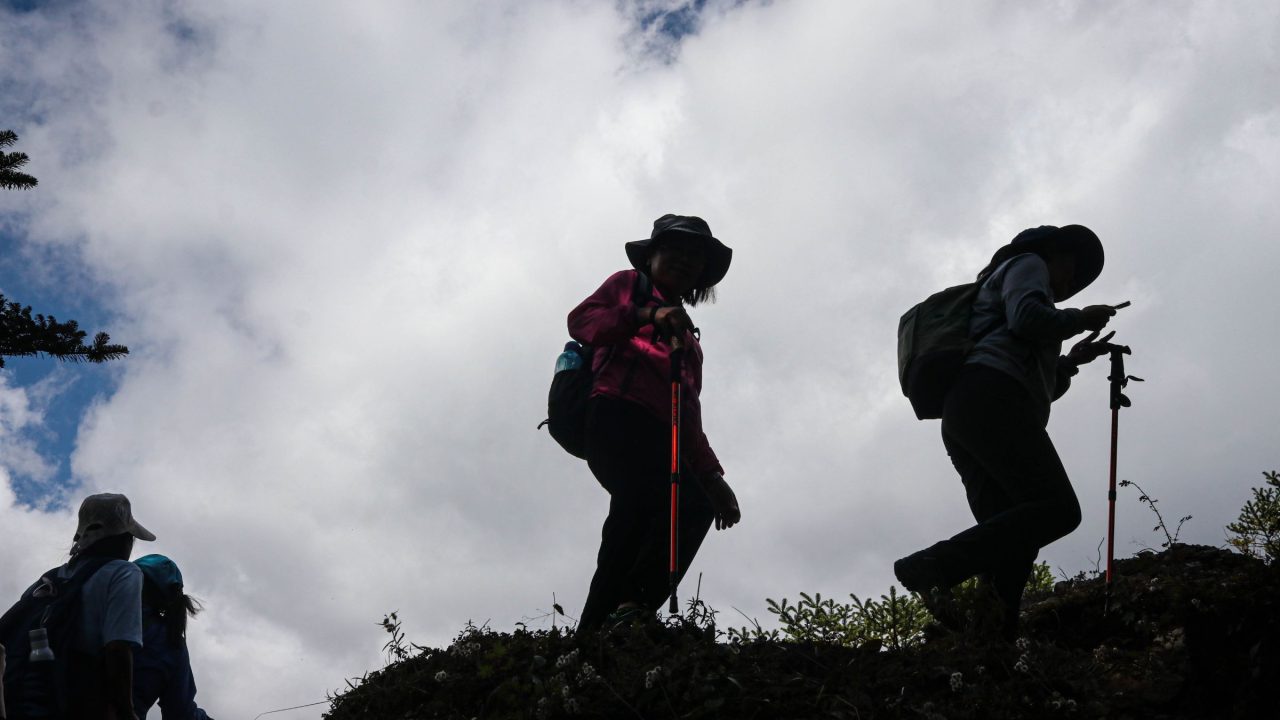
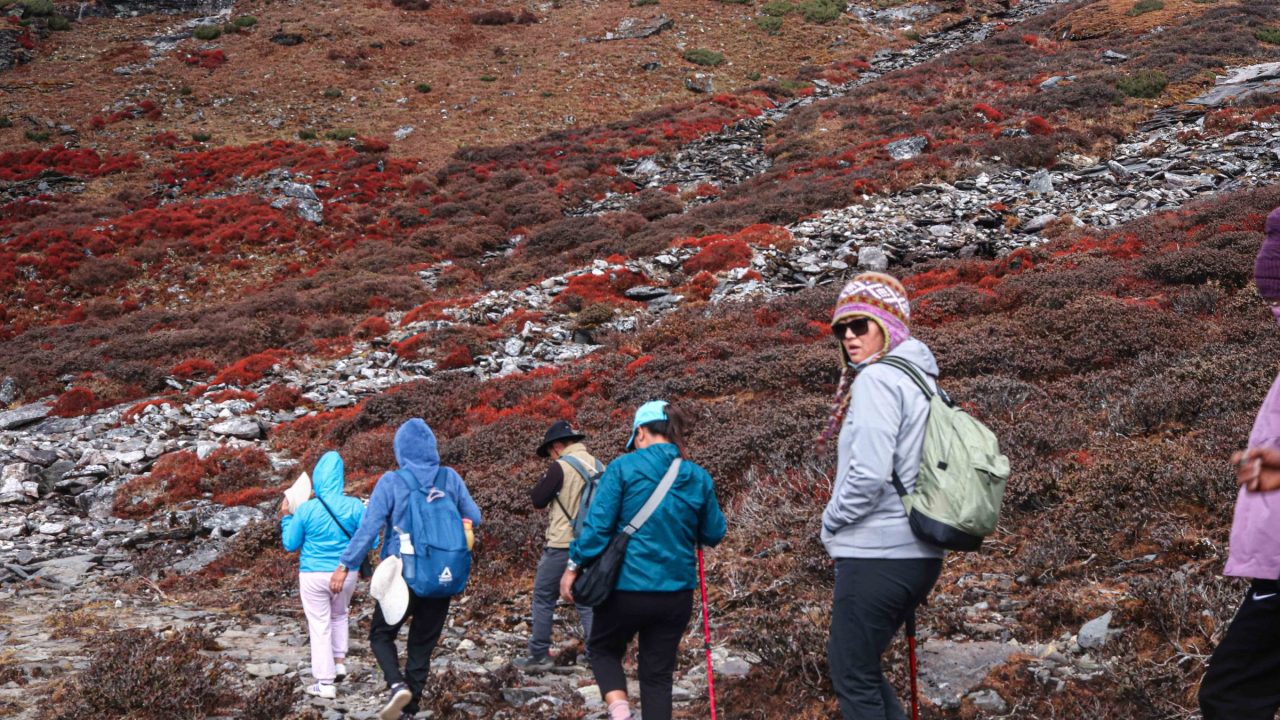
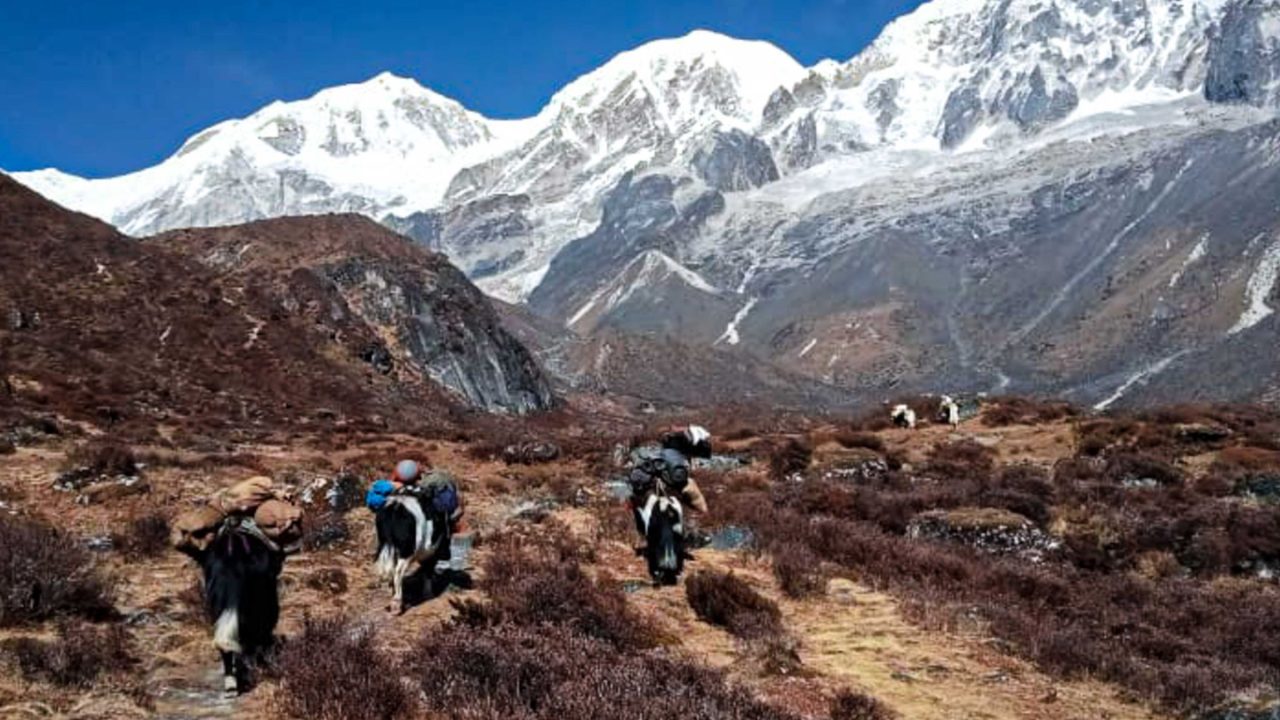
Welcome to Sangkhola, a small village located on the bank of Rimbi river where the Dafey Bhir trek begins. Sangkhola means “together river” because it is the meeting point of three rivers. Tonight, you will stay in a tent at our campsite where you can enjoy the peaceful sound of the river. During the introduction session, the guide will brief you about the trek. You can also choose to stay at a homestay at your own expense.
We will walk from Sangkhola to Naya Patal, which is 2360 meters high. After having tea, we will visit Seven Brothers waterfalls, which is a beautiful and peaceful falls located above the village. The trek will start after breakfast, and we will climb uphill for about an hour and a half to Chongri, which is the last village in the Yambong valley and is known for yak herding. After passing through the village, we will reach Chudzom river where we will offer a prayer to seek permission to enter the land of Yambong, as per the traditional belief of the villagers. We will trek for another 2 hours and finally reach the Naya Patal valley, which offers splendid views of the landscape below. In the evening, we will have a session to discuss the trek and spend the night in tents.
We’ll be hiking from Naya Patal to Yambong, which is at an altitude of 3693 meters. During our walk, we’ll pass through a bamboo and rhododendron forest, which is currently in its wild fruiting season. The forest is home to some endangered species such as the Satyr Tragapon and Red Panda. After traversing the pine forest, we’ll reach the Yambong valley, which is a stunning open valley where the tree line ends. If the sky is clear, it’s a great spot for stargazing. We’ll also have a session tonight where we’ll learn more about Yambong and its history. We’ll be spending the night in tents.
Today morning, we will be walking around 900 meters to reach Bhaley Dunga, which is a sacred and holy standing rock. We will offer prayers for our journey ahead and then have breakfast. After that, we will trek above the tree line, through the sub-alpine landscape with beautiful shrubs and flowers all over the valley. We will then continue with a short and gentle climb in the sub-alpine zone and witness our first alpine lake, “Goyem Lake,” which is said to be the deepest one. After walking for an hour, we will reach “Lam Pokhari,” meaning the longest lake. Tonight we will camp just below the lake. There will be no session tonight, as we would like everyone to take good rest. However, if anyone has any questions, feel free to ask us. We will be staying overnight in tents
After enjoying morning tea with a scenic lake view, we will head to the top of the Dafey Bhir Pass for breathtaking views of mountains like Kanchendzonga, Pandim, Tenzigang, Koktang, Three Sisters, Everest, Mahakalu, and Lhotse, as well as the surrounding eight alpine lakes. We will visit the wish-fulfilling Laxmi lake and the sacred Tingmo lake in Nepal before returning to camp for lunch. In the evening, we’ll have a session about the pass, lakes, folktales, and history. Overnight stay in tents
We’ll wake you up at 3 am to catch the sunrise over the mountains. After breakfast, we’ll hike down to Shaile Chowk, the longest route of the trek. Shaile Chowk is a small ground in a bamboo forest and is known to be home to the Red Panda. We’ll have a bonfire and chat tonight to discuss your feedback and suggestions for our VOYAZEBUDDY trek. Overnight in tents
Shaile Chowk to Chongri (2180 m)
We will descend down towards Chongri village. We will camp in our campsite close to the village. Tonight is celebration for the end of our beautiful trek. Cake cutting Ceremony with Bonfire, Tongba, Local wines, Songs, Dances, sharing and many more, the last dinner….
Overnight in the tents. (can stay at homestay on own expenses
Back to Sangkhola
Descend down for hour and half. Time to say good bye. Will drop you back to Siliguri (if its included)
Dafey Bhir Trek Rules and Regulations
Embark on an unforgettable adventure with our all-inclusive trekking package to Kanchendzonga. Discover the beauty of the region while enjoying a hassle-free experience with our comprehensive inclusions.
- Meals:
- Varied and delicious vegetarian meals are provided throughout the trek. Non-vegetarian Meal also available on request.
- Inclusive of breakfast, lunch, evening snacks, dinner.
- Tea, coffee, and hot soup.
- Entry Fees and Permits:
- All necessary entry fees and permits are covered.
- Accommodation:
- Options include camping and homestay.
- One night’s accommodation at Sangkhola in a homestay on a sharing basis, dinner.
- Experienced Team:
- Mountaineering qualified and professional guide.
- Skilled cook to ensure delightful culinary experiences.
- Excellent trekking guide with profound knowledge of the trekking trails.
- Support staff, porters/pack animals for logistic support.
- Safety and Medical Support:
- First aid medical kits.
- Oxygen cylinder
- Oximeter
- Trekking Equipment:
- Sleeping bag and mattress
- Sharing Basis tent
- Kitchen tent and toilet tent
- Utensils and crampons (For hygiene, it is recommended to carry lightweight ones.)
- Personal sleeping bag recommended for hygienic reasons.
Services Included:
- Permits and Permissions:
- High altitude trekking permits/permission.
- National Park fees and permissions.
- Tourism fees and permissions.
- Environmental fees.
- Local Support:
- Local English-speaking guide.
- Experienced local cook.
- Mules or porter for carrying personal luggage.
- Trekking Essentials:
- Hot water bags.
- Personal Expenses:
- Any personal expenses, including mineral water bottles, bottled or canned beverages, etc.
- Natural Incidents:
- Costs incurred due to natural reasons.
- Sickness-related Returns:
- Expenses if any member returns from the trek route due to sickness.
- Unspecified Expenses:
- Anything not specifically mentioned under the inclusion section.
- Early Return Costs:
- Any early return travel costs or accommodation, except for the days as per the itinerary.
- Medical Treatment:
- Expenses for medical treatment of injury or accident before, during, or after the trek.
- Transportation:
- Food during transportation.
- Transportation from NJP/Bagdogra to Uttarey and return to NJP/Bagdogra.
- Tip/Gratuity:
- Any tip/gratuity to the HT support staff.
- Unspecified Expenses:
- Anything not mentioned in the “Inclusions” or personal in nature.
Exclusion Services:
- Travel Tickets:
- International and domestic flight tickets.
- Transportation:
- Transportation to/from the starting and ending location.
- Insurance:
- Insurance of any nature.
- Beverages:
- Alcohol and beverages.
- Shopping:
- Personal shopping costs.
- Unspecified Expenses:
- Anything not included in the included list.
- Trekking Gear:
- Good pairs of trekking boots (Sturdy trekking shoes with good grip, ankle support, and snow-handling capability) *.
- Extra pairs of socks (Waterproof and cotton/woolen) *.
- Two pairs of sports socks for cushioning and warmth.
- One pair of woolen socks for additional warmth.
- Synthetic socks or blends recommended for quick drying.
- Pair of comfortable track pants (3 Layers Recommended) *.
- Clothing:
- Scarf.
- Balaclava to cover your ears.
- Warm clothes (5 Layers Recommended) *.
- Base Layer (3 T-Shirts):
- Full-sleeve dry-fit T-shirts (preferably collared) to prevent sunburn.
- Carry one and wear two for flexibility.
- Synthetic fabrics like dry-fit are preferable for quick drying.
- Pro Tip: Consider thermal inners for extra cold sensitivity or layer two T-shirts for effective insulation.
- Insulation Layers (4 Warm Layers):
- 1 pair of inner thermals, light fleece layers, 1 light sweater, and 1 padded jacket.
- Opt for compact, lightweight sweaters and fleece jackets.
- Hooded padded jackets are suitable for the outer layer.
- Down/feather jackets are not necessary; regular padded/shell jackets suffice.
- Two Trek Pants:
- Opt for quick-dry trek pants with zippered cut-offs at the thighs.
- Two pairs for flexibility and a spare in case of rain.
- Zippered pockets are convenient for storing essentials.
- Buying Tip: Choose pants with zippered pockets; prioritize quick-dry material.
- Track pants can serve as thermal bottoms but keep them as a backup, not main outerwear.
- Gloves (Waterproof and woolen recommended) *.
- Waterproof synthetic gloves with padded lining.
- Essential for warmth on the trek.
- Tight-fitting fleece gloves can be worn inside synthetic gloves.
- Cap*
- Essential for protection against sunburn, headaches, and sunstrokes.
- Flap-equipped sun caps provide added UV protection.
- Wide-brimmed sports hats are effective in preventing sunburn.
- Ensure coverage of ears; crucial for heat retention.
- A woolen cap or balaclava is essential during cold temperatures.
- Balaclava covers the ears, neck, and parts of the face.
- Thermal innerwear*.
- Windproof jackets or puffer Jackets. *
- Rain Protection:
- Rain cover*.
- Light umbrella/raincoat.
- Carry a poncho or rain jacket for sudden weather changes.
- Poncho is effective, covering both you and your backpack.
- Rain jackets are streamlined but heavier.
- Rain Cover for Backpack:
- Essential to keep your backpack and contents dry.
- Modern backpacks may have built-in rain covers.
- Use a rain cover or plastic sheet cut to size if not included.
- Hygiene and Personal Care:
- Light quick dry towel*.
- Reusable water bottle*.
- Skin care creams (Sun Screen SPF 50 recommended).
- Polarized glasses (for snow and wind) *.
- To prevent snow blindness due to UV rays on snowy stretches.
- Buying Tip: Opt for sunglasses that wrap around for complete UV ray protection.
- Spectacle Wearers: Consider oversized sunglasses or photochromic lenses.
- Headlights with extra batteries*.
- Headlamp is preferred for hands-free activities.
- Must-have for tasks like washing dishes, pitching tents, and holding trek poles.
- Ensure the headlamp covers a wider area for better visibility.
- Trekking Poles (A Pair):
- Enhances stability and balance, reducing energy consumption.
- Especially useful for steep ascents and descents.
- Two trekking poles offer greater stability and increased walking pace.
- Additional Essentials:
- Two pairs of quick-dry tees.
- If you bring your valuable and heavy camera and electronics and want a horse to carry, the risk is on you.
- Two backpacks – one small, which you will carry with items needed while walking, and another with your other stuff. (One 50–60-liter backpack with excellent hip and shoulder support, along with quick access pockets.)
Power bank (as no power supply is available. Solar power on request)
- Daypack (20-30 liter, Optional):
- Small backpack for essentials like water bottles, rainwear, snacks, and a warm layer.
- Main backpack accessible only at campsites.
- Avoid using laptop bags as daypacks; opt for 20–30-liter capacity.
Note: Items with (*) are must-required.
Ensure you are well-prepared for your trekking adventure by packing these essential items.
The items marked with (*) are crucial for your comfort and safety during the trek.
- Toilet Kit:
- Keep it light with essentials: toothbrush, toothpaste, small soap, toilet tissue rolls, small moisturizer, lip balm, and roll-on deodorant.
- Pro Tip: Opt for miniature-sized items to keep the kit light and share toothpaste if trekking in a group.
- Pro Tip: Use the smallest size toilet rolls; avoid large rolls.
- For Women: If expecting your period, use pads, tampons, or menstrual cups. Carry Ziplock bags for menstrual waste disposal.
- Cutlery:
- Carry a leakproof lunch box, a mug, and a spoon.
- Pro Tip: Stainless steel cutlery is recommended for easy washing and hygiene.
- Pro Tip: Wash your cutlery individually to avoid mass washing systems and reduce the risk of stomach disorders.
- Two 1-litre bottles or a 2-litre hydration pack: Ensure hydration with two 1-litre water bottles or a hydration pack for the approximately 6 hours of daily trekking. A lightweight thermos is useful for warm water on cold days.
- Plastic Covers:
- Carry 3-4 old plastic covers for used or wet clothes.
- Reuse old plastic bags; avoid buying new ones.
For Indians:
- Original and 3 photocopies of government photo identity card.
- 3 passport-size photos.
- Original and 3 photocopies of Medical Certificate (first part to be filled by a doctor and second part by the trekker).
- Original and 3 photocopies of Disclaimer form (to be filled by the trekker).
For Foreigners:
- Original and 4 copies of Inner Line Permit (ILP).
- 4 passport-size photos.
- Original and 4 copies of Passport.
- Visa in Original and 4 copies.
- Original and 4 photocopies of Medical Certificate (first part to be filled by a doctor and second part by the trekker).
- Original and 4 photocopies of Disclaimer form (to be filled by the trekker).
Note: All documents need to be downloaded (PDF), filled in, signed, and handed over to the trek leader at the base camp. Please be aware that there is no facility to get printouts and photocopies at Uttarey.
- Phoktey Dara Viewpoint:
- One of the finest viewpoints in the entire Singalila range.
- Highest Mountains of the World:
- Stunning and panoramic views of some of the highest mountains globally, including Mt. Everest, Mt. Lhotse, Mt. Makalu, Mt. Kanchendzonga, and others.
- Sleeping Buddha Mountain View:
- Witness the famous sleeping Buddha formation of Mt. Kanchendzonga and its group of peaks.
- Rhododendron Forest:
- Explore a pristine and undisturbed forest of Rhododendrons, featuring a variety of species.
- Flora and Fauna:
- Encounter many endangered and exotic animals and plants along the trek.
- Less Explored Himalayan Trail:
- Traverse a pristine and less-explored Himalayan trail, offering a unique trekking experience.
- Sangkhola Village:
- Experience life in a typical Himalayan village settlement, Sangkhola.
- Dafey Bhir Viewpoint:
- Visit one of the most beautiful and highest viewpoints in the Singalila Ridge, providing majestic and up-close views of Mt. Kanchendzonga and several other snow-capped mountain peaks.
- Optimal Rest Position:
- While resting, lie against a tree trunk, large stone, or on flat ground.
- Elevate your legs on your bags or any available higher ground to regulate blood circulation.
- Adjustment Stops:
- Stop at any comfortable point after starting to readjust your rucksack, jackets, or tie shoelaces for better comfort and adjustment.
- Strategic Halts:
- Avoid frequent or prolonged halts that disrupt the walking rhythm.
- Follow your rhythmic walking pace and technique to prevent unnecessary tiredness.
- Choose natural stopping points like the top of a ridge, before an ascent, or at a scenic viewpoint.
- Considerate Stops:
- Stop and position yourself on the safer (mountain) side to allow pack animals to pass through.
- Avoid bags carried by animals that may push you.
Be aware of yak horns to ensure safety during animal crossings.
- Pace Yourself:
- Avoid the temptation to walk fast out of excitement.
- Walk at a slow, comfortable pace to warm up gradually before pushing yourself.
- Personal Rhythm:
- Develop a personal rhythm and synchronize steps with breathing to minimize breathlessness.
- Foot Placement:
- Walk with caution on Himalayan trails with loose soil and rocks.
- Avoid stepping on loose surfaces; place your foot flat and firm for a better grip.
- Follow the ‘heel first’ rule while walking on Himalayan trails.
- Zigzag Technique:
- Ascend steep slopes in a zigzag manner.
- Descend zigzag to reduce pressure on knees, preventing knee pain and blisters.
- Safety First:
- Avoid stepping on loose stones and soil to prevent accidents.
- Overtaking Etiquette:
- Refrain from overtaking on narrow trails; do so only at comfortable wide spaces if necessary.
- Maintain Distance:
- Keep sufficient space between trekkers while ascending or descending to prevent stone rolling accidents.
- Descending Technique:
- Bend knees slightly while descending; avoid running down slopes.
- Dig heels into soft snow or ground for stability.
- Avoid Slippery Areas:
- Be cautious of wet grass, wet roots, and muddy zones, which can be slippery in the Himalayan conditions.
- Avoid Shortcuts:
- Steer clear of shortcuts on foot trails for safety.
- Stay Warm During Rests:
- Wear warm clothing during breaks to prevent cold, cough, and altitude sickness.
- Respect Local Customs:
- Respect the sentiments and traditions of local hill people.
- Stay Hydrated:
- Carry enough water to avoid altitude sickness.
- Wear Comfortable Gear:
- Choose comfortable trekking boots, pants, and jackets.
- Avoid wearing new trekking boots directly on the trek; break them in beforehand.
- Carry all necessary clothing for varying conditions.
Spring (Mid-March, April to May):
- Sangkhola and around:
- Morning and Evening: 12 to 16 degrees Celsius
- Daytime: 18 to 24 degrees Celsius
- Late Evening and Midnight: 8 to 14 degrees Celsius
- Lam Pokhari and above:
- Morning and Evening: 4 to 12 degrees Celsius
- Daytime: 12 to 18 degrees Celsius
- Late Evening and Midnight: -10 to 4 degrees Celsius
Autumn (Mid-September, October to November):
- Sangkhola and around:
- Morning and Evening: 8 to 14 degrees Celsius
- Daytime: 16 to 21 degrees Celsius
- Late Evening and Midnight: 2 to 10 degrees Celsius
- Lam Pokhari and above:
- Morning and Evening: -8 to 10 degrees Celsius
- Daytime: 2 to 14 degrees Celsius
- Late Evening and Midnight: -15 to 2 degrees Celsius
Please note that these temperature ranges are approximate, and the actual weather conditions can vary. Weather in the Himalayas is unpredictable, and it is advisable to be prepared for sudden changes. Ensure you have appropriate clothing to stay comfortable in varying temperatures.
- Read and Understand Terms & Conditions:
- Ensure that you have thoroughly read and understood the “Terms & Conditions” before proceeding with the booking.
- Select the Trek:
- Choose the Fixed Departure/Scheduled trek or discuss your preferences for a Customized/Private trek.
- Payment of Booking Amount:
- Pay 25% of the Trek/Tour Fee as the initial “Booking Amount.”
- Payment Methods: Net banking, Cash, Credit/Debit cards, AMEX cards.
- Payment Confirmation:
- Upon payment of the booking amount, your participation in the desired trek is confirmed.
- Your place on the scheduled date will be reserved.
- Remaining Amount:
- Pay the remaining amount at least 15 days before the scheduled start of the trek.
Please ensure timely payment to secure your spot on the trek and complete the remaining payment well in advance of the trek start date. If you have any specific questions or need assistance during the booking process, feel free to reach out to the trek organizers.
- Non-Refundable Booking Amount:
- The “Booking Amount,” which is 25% of the Trek/Tour Fee, is non-refundable at any stage.
- Flexibility for Unavoidable Reasons:
- If you are unable to participate due to unavoidable reasons, you have the flexible option to shift to another trek within the next one year.
- The one-year period is calculated from the starting date of the initially booked trek/tour.
- Postponement Policy:
- Inform at least 15 days before the trek/tour starting date for postponement.
- Postponement within 15 days is subject to approval and should be requested in writing through your registered email.
- Cancellation Charges:
- Cancellation/Postponement between 14 days to 8 days before the starting date incurs a 50% cancellation charge.
- No shifting of dates is allowed within this period.
- No Refund within 7 Days:
- If you cancel a trek/trip within 7 days (a week) before the starting date, there will be NO REFUND.
- Unforeseen Incidents:
- In the event of unforeseen incidents like natural calamities, political unrest, etc., leading to the cancellation of the trek/trip by the organizers, you can redeem the full amount for the same/similar trek/trip within the next one year.
Please note the specific conditions and timeframes for cancellation, postponement, and refund eligibility. It is advisable to communicate any changes or cancellations well in advance and follow the specified procedures for a smoother process.
Top of Form
CANCELLATION RULES
- Up to 30 Days:
- 90% of Trek/Adventure program cost will be refunded.
- Between 30-15 Days:
- 50% of Trek/Adventure program cost will be refunded.
- Less than 15 Days:
- No refund.
Important Notes:
- All programs are subject to change due to political reasons, natural calamities, serious sickness, and special reasons.
- Cancellation charges apply to reductions in group size, not only for cancellations of entire bookings.
- The operator reserves the right to change/modify the itinerary due to unforeseen disruptions by natural forces. If any costs increase due to this change, the client would be requested to pay the additional amount.
